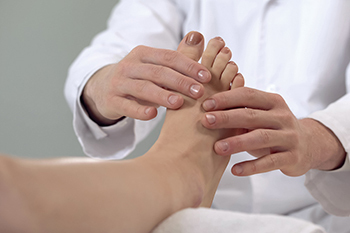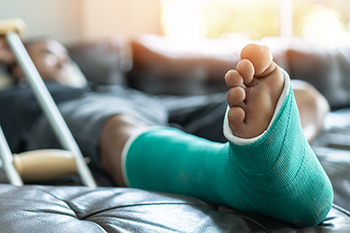Items filtered by date: October 2022
Stretching as a Runner

If you are a runner, you are no doubt intimately acquainted with the importance of taking care of your body to ensure that you are running in the most healthy way possible. One practice that people believe might help prevent running injuries is performing certain stretches of the feet. Stretching can significantly improve the extent to which your body can absorb energy when running, which might go a long way in preventing injuries. The benefits of stretching as a runner might not be limited to the feet. Stretching could also reduce aches and pain in areas throughout the body that are tight. You may choose to stretch before a workout as a way to warm up, or immediately after a workout as a form of a static stretch. Contact a chiropodist today to learn additional methods to prevent running injuries.
Although running is a wonderful exercise to keep you in shape, it can wreak havoc on your feet and ankles if you don’t take preventive measures. If you have sustained a foot and ankle injury from running, please consult with one of the chiropodists from Complete Family Footcare & Therapy. Our clinicians can help you maintain the health of your lower limbs and your mobility.
Some common running injuries include:
-
Achilles tendonitis
-
Shin splints
-
Ankle sprains
-
Stress fractures
-
Plantar fasciitis
-
Bursitis
What causes injuries?
These injuries are usually caused by overtraining, wearing the wrong shoes, running on hard surfaces, having tight and inflexible muscles, or having biomechanical issues in the feet or ankles.
What can I do to prevent injuries?
-
Train slowly and gradually
-
Give yourself plenty of time to recover following a run
-
Wear shoes that fit properly and support your foot
-
Avoid running on hard surfaces, like concrete
-
Stretch and strengthen the muscles of your lower legs
-
Warm-up prior to a run
-
Have your gait analyzed and your feet examined by a chiropodist to determine if there are any biomechanical problems that need to be treated
If you have any questions, please feel free to contact our offices located in . We offer the newest diagnostic and treatment technologies for all your foot care needs.
Who Is at Risk for Getting Athlete’s Foot?

The foot condition that is known as athlete’s foot is considered to be contagious. It can be uncomfortable and unsightly, and is caused by a fungus. This is not a serious condition, despite the fact it can be difficult to cure. There are specific groups of people who may be at risk for developing athlete's foot. These can consist of patients who are frequently in locker rooms, use public swimming pools, have sweaty feet, or who choose to share towels, socks and shoes. The symptoms that are commonly experienced with this condition can include red skin, which may crack and peel, brittle toenails, and blisters may develop on the feet that can itch. Athlete’s foot typically does not heal on its own, and if you are afflicted with this condition, please contact a chiropodist who can prescribe the correct medication for you.
Athlete’s foot can be uncomfortable and unsightly. To learn more about preventing and treating this condition, please consult with one of the chiropodists from Complete Family Footcare & Therapy. Our clinicians will assess your condition and provide you with quality foot and ankle treatment.
What Is Athlete’s Foot?
Athlete’s foot refers to an infection of the skin on the feet that is caused by a fungus. This fungus is contagious and thrives in warm and moist environments. It is often spread in common areas such as public pools, locker rooms, and showers. It can also spread when sharing personal items, like shoes or towels, with an infected person.
Symptoms
The symptoms of athlete’s foot may include:
-
Itching, stinging, or burning of the skin on the feet
-
Cracking or peeling skin, especially between the toes and on the soles of the feet
-
Scaly, red rash on the foot
-
Blisters
-
Foul odor
Treatment
Treatment for athlete’s foot typically involves using over-the-counter topical antifungal medications on the feet. When over-the-counter options are ineffective, you may need to take prescription oral medications or topical antifungal drugs, or a combination of both.
Prevention
Preventing athlete’s foot places an emphasis on good foot hygiene practices.
You can prevent athlete’s foot by:
-
Washing and drying your feet thoroughly every day
-
Wearing shoes when walking in public areas
-
Not sharing personal items, like shoes or socks, with others
-
Wearing shoes and socks made out of breathable materials
If you have any questions, please feel free to contact our offices located in . We offer the newest diagnostic and treatment technologies for all your foot care needs.
Safety Stirrups for Young Horseback Riders
 Doctors advocate that young equestrians wear strong boots and use safety stirrups while horseback riding. These safety measures are thought to prevent broken foot bones. A study done of young horseback riders in Switzerland found that foot injuries occurred from falling to the ground while one was riding. The foot can become trapped under the horse while still in the stirrup and the stirrup can bend the foot unnaturally and break it in several places under the impact. With just a little pressure, safety stirrups open and release the rider’s foot. If you are the parent of a budding equestrian, see a chiropodist for other preventative injury measures and for the proper treatment if an injury does occur.
Doctors advocate that young equestrians wear strong boots and use safety stirrups while horseback riding. These safety measures are thought to prevent broken foot bones. A study done of young horseback riders in Switzerland found that foot injuries occurred from falling to the ground while one was riding. The foot can become trapped under the horse while still in the stirrup and the stirrup can bend the foot unnaturally and break it in several places under the impact. With just a little pressure, safety stirrups open and release the rider’s foot. If you are the parent of a budding equestrian, see a chiropodist for other preventative injury measures and for the proper treatment if an injury does occur.
Injuries to the foot and ankle are very common among athletes. If you have experienced an injury, please consult with one of the chiropodists from Complete Family Footcare & Therapy. Our clinicians will assess your condition and provide you with quality foot and ankle treatment.
Common Injuries Among Athletes:
-
Achilles tendon injuries
-
Ankle strains or sprains
-
Plantar fasciitis
-
Fractures
-
Turf toe
-
Joint dislocations
-
Sever’s disease
-
Morton’s neuroma
Symptoms
Symptoms will depend on the cause and severity of the injury. Common symptoms for a foot or ankle injury include pain, swelling, tenderness, bruising, a reduced range of motion, and difficulty bearing weight or walking on the affected foot or ankle.
Diagnosis
Sports injuries are typically diagnosed after carefully examining the affected foot or ankle. This includes moving the injured area to test its range of motion. Medical history will need to be provided, as well as detailed information about how the injury occurred. Imaging studies, such as X-rays or MRIs, may be used to confirm or rule out certain diagnoses.
Treatment
Just like symptoms, treatment will depend on the type of injury and its severity. Initial treatment for many sports injuries is aimed at controlling inflammation and promoting the healing response. The acronym R.I.C.E is a helpful guide to implement for most acute injuries. This method involves resting, icing, compressing, and elevating the affected foot or ankle. In addition, anti-inflammatory medications may be administered and orthotic devices may be prescribed. For more severe injuries, surgery may be required. Lastly, rehabilitation or physical therapy may be needed to gain full functionality in the afflicted area.
If you have any questions, please feel free to contact our offices located in . We offer the newest diagnostic and treatment technologies for all your foot care needs.
We Can Treat Your Foot or Ankle Pain
Preventing Older Adult Falls

Falls are common and often the leading cause of injury and death in those aged 65+. However, many falls are preventable. People in this age group can take steps to keep themselves safe and independent longer. Seniors can check their medications and supplements to see if they have side effects like dizziness or sleepiness that might cause falls. They can get their eyes checked annually and make sure their glasses are updated as often as need be. Exercises can be done to make legs stronger and improve balance. Homes can be checked for trip hazards, grab bar placement, and proper lighting. Well-fitting and supportive footwear should be worn. If you are elderly or taking care of a person in this age group, seeing a chiropodist is suggested for regular foot checks, to answer any questions, and provide useful tips about falls prevention.
Falls are a major cause of injury among the elderly. To learn more about preventing falls or to get treatment following a foot or ankle injury caused by a fall, please consult with one of the chiropodists from Complete Family Footcare & Therapy. Our clinicians will assess your condition and provide you with quality foot and ankle treatment.
Falling is one of the leading causes of injury among the elderly. It is said that about 50% of falls that result in hospitalization occur in the home. Fortunately, there are steps that you can implement to reduce your risk of falling in the home.
Tips to Prevent Falls at Home:
-
In the bathroom - Place non-slip mats in the shower or tub, install grab bars near the toilet and bath, and wipe up any moisture or spills as soon as possible.
-
In the living rooms and bedroom - Remove loose wires, cords, or other objects that may be an obstacle to moving around safely. Make sure that you have good lighting throughout the home so that you can always see where you are going. Get rid of any rugs or mats that are not firmly anchored or that may cause you to trip. When walking around the home, move slowly.
-
In the kitchen - Store food and supplies in easily accessible areas, store heavy items in lower cupboards, and wipe up any spills immediately to prevent slipping.
-
On the stairs - Make sure that the stairs are well-lit and have secure handrails. Walk slowly when ascending or descending the stairs.
-
Outside - Keep walkways well-lit and clear of snow, ice, leaves, and man-made tripping hazards.
Maintaining your overall health, including the health of your feet, can also help to prevent falls. Eat a healthy diet, exercise regularly, and wear well-fitted, comfortable, and supportive shoes. If you have a mobility device, such as a cane, use it while walking.
If you have any questions, please feel free to contact our offices located in . We offer the newest diagnostic and treatment technologies for all your foot care needs.

